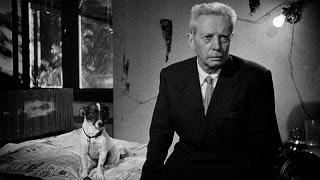 Umberto D. (1952) marked the neorealist movement's last hurrah. International critics better appreciated Vittorio De Sica's bleak masterwork than his countrymen; domestic audiences ignored the film, while the Italian government tried banning its export for its unflattering view of Italy. Time has vindicated Umberto D., now accept as one of De Sica's best works.
Umberto D. (1952) marked the neorealist movement's last hurrah. International critics better appreciated Vittorio De Sica's bleak masterwork than his countrymen; domestic audiences ignored the film, while the Italian government tried banning its export for its unflattering view of Italy. Time has vindicated Umberto D., now accept as one of De Sica's best works.Retiree Umberto D. Ferrari (Carlo Battisti) lives on a small government pension, with only his terrier Flike for companionship. He bickers with his landlady (Lina Gennari), who rents his apartment to a young couple. Unable to make rent, Umberto befriends the flat's pregnant housemaid (Maria-Pia Casilio) and winds up in the hospital. Upon release he becomes even more destitute before, especially when Flike runs away.
Shot in stark black-and-white on Roman locations, Umberto D. conveys a landscape strewn with despair. Pensioners protest their iniquitous wages, and police attack them; hospitals and soup kitchens overflow with destitute workers and sick children. An old man insults the protestors for not getting a permit, while the landlady refuses compromise on her immediate payment. He's forced to beg for money, using his dog to perform tricks. It makes Bicycle Thieves look positively sunny.
For all its studied actuality, Umberto D. shamelessly works the viewer's heartstrings. Umberto struggles to connect with society, a senior citizen treated as human refuse by indifferent Romans. His only friendship comes with a maid who, carrying an illegitimate child, is even more an outcast than he. His landlady scorns him and even a friend seems oblivious to his requests for help. Umberto's driven to the ultimate despair, only for Flike to save him.
While Umberto D. employs a few professional actors, Carlo Battisti is the film's heart. A distinguished linguistics professor, Battisti performs in a bone-weary register, suggesting a man truly at the end of his rope. De Sica coaxes a more subtle performance than we'd expect from a nonprofessional, with Battist neither overplaying nor coming off as stiff; his line readings and gestures register a broken man, grasping at memories and faint hopes.
As characteristic of neorealism, Umberto D. manages a bittersweet coda. Reunited with Flike, Umberto begins playing with the dog in a park, suggesting that he's found something to live for. Yet De Sica's camera pulls back, shrinking Umberto within a park teeming with indifferent Italians who barely notice him, as Mahler portentously blares from the soundtrack. Life goes on, misery remains, and some can only appreciate fleeting happiness.

